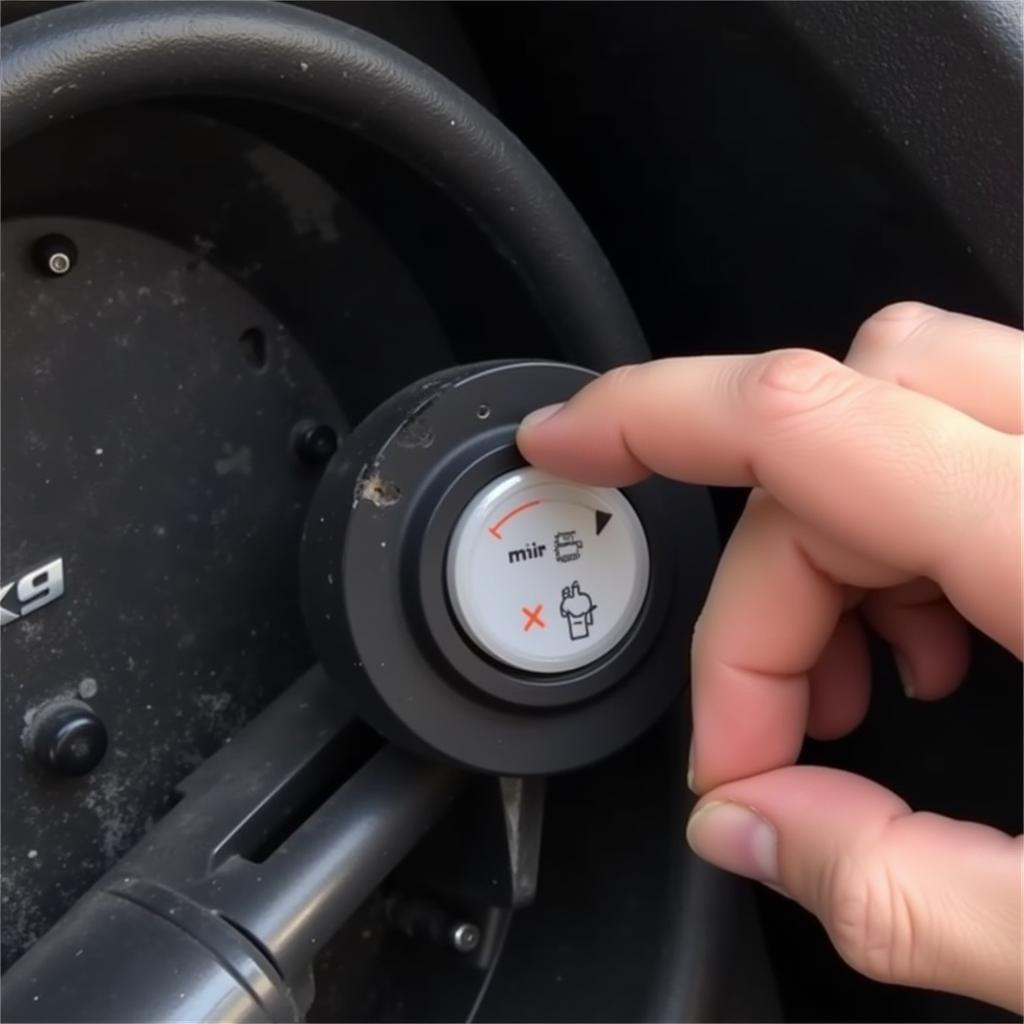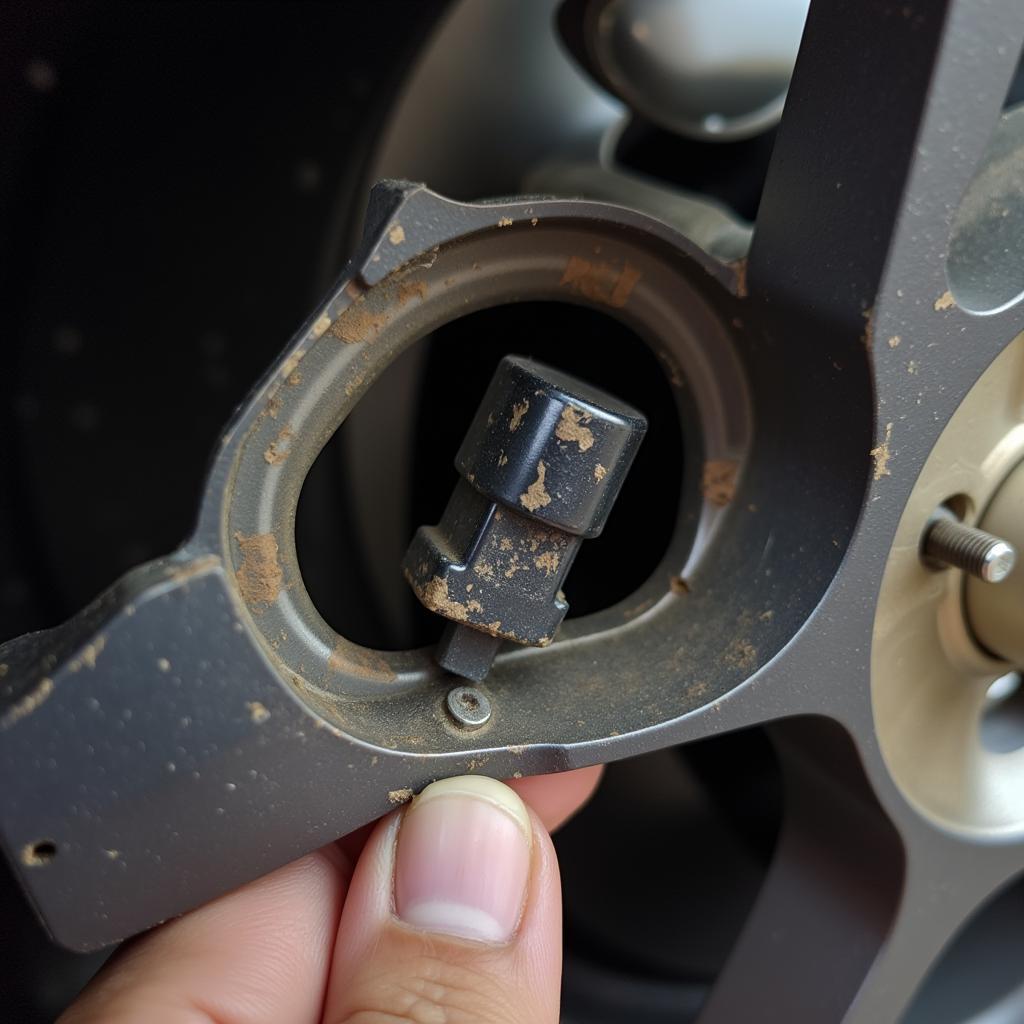The “Check Brake System” warning on your Ford F150 dashboard can be a cause for concern. While this powerful truck is built for tough jobs, brake problems can sideline even the mightiest F150. This comprehensive guide will explore the common reasons behind this warning light, what it means for you, and how to diagnose and address the issue.
Understanding Your F150’s Brake System
Before delving into the causes of the “Check Brake System” warning, it’s essential to grasp the basics of your F150’s brake system. The system comprises several key components working in unison to ensure safe and effective braking.
- Brake Pedal: The interface between you and the system, transferring force to the master cylinder.
- Master Cylinder: A hydraulic pump that amplifies the force from your foot and distributes it to the brakes.
- Brake Lines: The network of metal tubes carrying pressurized brake fluid to the wheels.
- Brake Calipers and Wheel Cylinders: These components house pistons that push brake pads or shoes against the rotors or drums.
- Brake Pads and Shoes: Friction materials that clamp down on the rotors or drums, creating the stopping force.
- Rotors and Drums: Metal discs or drums connected to the wheels, providing a surface for the pads or shoes to grip.
- Anti-lock Brake System (ABS): An electronic system preventing wheel lockup during hard braking, maintaining steering control.
- Electronic Brakeforce Distribution (EBD): Works in conjunction with ABS to distribute braking force optimally between front and rear wheels.
Common Causes of the “Check Brake System” Warning
Now that you understand the key components, let’s investigate the reasons why your F150 might display the “Check Brake System” warning:
1. Low Brake Fluid Level
One of the most frequent culprits behind the “Check Brake System” warning is low brake fluid. Brake fluid plays a crucial role in transmitting force from the master cylinder to the brakes at the wheels.
Possible Reasons for Low Brake Fluid:
- W Worn Brake Pads: As brake pads wear down over time, the brake calipers need to extend further to engage the rotors. This extension requires more brake fluid, potentially leading to a low fluid level.
- Brake Fluid Leak: A leak anywhere in the brake lines, hoses, or connections can cause a drop in brake fluid level.
- Worn Master Cylinder: Over time, the master cylinder’s seals can deteriorate, allowing brake fluid to leak internally or externally.
What to Do:
- Check the Brake Fluid Reservoir: Locate the brake fluid reservoir under the hood, usually on the driver’s side. Check the fluid level against the minimum and maximum markings.
- Add Brake Fluid (If Necessary): If the fluid level is low, carefully add the correct type of brake fluid recommended for your F150. Consult your owner’s manual or the reservoir cap for the correct fluid type.
- Inspect for Leaks: Visually inspect the brake lines, hoses, calipers, and the area around the master cylinder for any signs of leaks. Look for wet spots, drips, or stains.
 Checking Brake Fluid Level in F150
Checking Brake Fluid Level in F150
2. Worn Brake Pads
As mentioned earlier, worn brake pads are a common culprit for the “Check Brake System” warning. Brake pads are designed to wear down over time, and as they do, the brake system needs to compensate.
Signs of Worn Brake Pads:
- Squealing or Screeching Noises: High-pitched noises when applying the brakes are often the first indication of worn brake pads.
- Grinding Noise: A grinding sound during braking indicates that the brake pad material is completely worn down, and metal is rubbing against metal. This requires immediate attention.
- Vibration in the Brake Pedal: A pulsating sensation in the brake pedal can also signal worn brake pads, especially if accompanied by other symptoms.
What to Do:
- Inspect the Brake Pads: If you suspect worn brake pads, have them inspected by a qualified mechanic as soon as possible.
- Replace Brake Pads (If Necessary): If the brake pads are worn beyond the recommended thickness, they need to be replaced. It’s usually a good practice to replace both pads on the same axle, even if only one appears worn.
 Worn Brake Pads on a Ford F150
Worn Brake Pads on a Ford F150
3. Faulty Brake Light Switch
While less common than low brake fluid or worn brake pads, a faulty brake light switch can also trigger the “Check Brake System” warning in some F150 models. This switch is responsible for activating the brake lights when you press the brake pedal.
How a Faulty Brake Light Switch Can Cause the Warning:
- The brake light switch is connected to the brake system’s electrical circuit.
- A malfunctioning switch can disrupt this circuit, potentially causing the “Check Brake System” warning to illuminate.
What to Do:
- Check Brake Light Operation: Have someone observe the brake lights while you press the brake pedal. If the lights don’t illuminate, the brake light switch may be the culprit.
- Test the Brake Light Switch: This task typically requires some mechanical skill and tools. You can find online resources or consult a repair manual for guidance.
- Replace the Brake Light Switch (If Necessary): If the brake light switch is confirmed as faulty, it needs to be replaced.
4. ABS Sensor Problems
The Anti-lock Brake System (ABS) is a crucial safety feature in modern vehicles like the F150. ABS sensors, usually one at each wheel, monitor wheel speed and relay this information to the ABS control module.
How ABS Sensor Issues Trigger the Warning:
- Faulty ABS sensors can send incorrect signals to the ABS control module.
- The control module interprets these erroneous signals as a system malfunction, illuminating the “Check Brake System” warning.
What to Do:
- Check for Diagnostic Trouble Codes (DTCs): A qualified mechanic can use a scan tool to retrieve DTCs stored in the vehicle’s computer. These codes can pinpoint the specific ABS sensor causing the issue.
- Inspect ABS Sensors and Wiring: Visually inspect the ABS sensors and their wiring harnesses for damage, corrosion, or loose connections.
- Replace Faulty ABS Sensor(s): If an ABS sensor is diagnosed as faulty, it needs to be replaced.
 Location of an ABS Sensor on a Ford F150
Location of an ABS Sensor on a Ford F150
5. Issues with the Master Cylinder
The master cylinder, a vital component of the hydraulic brake system, can also be a potential cause for the “Check Brake System” warning.
How a Faulty Master Cylinder Can Cause Problems:
- Internal Leaks: Worn seals within the master cylinder can lead to internal fluid leaks, reducing hydraulic pressure and compromising braking performance.
- External Leaks: A cracked or damaged master cylinder can result in external brake fluid leaks, also leading to low fluid levels and reduced braking effectiveness.
What to Do:
- Inspect the Master Cylinder: Carefully examine the master cylinder for any signs of leaks, such as wetness, drips, or fluid accumulation around the unit.
- Check for Brake Pedal Feel: A spongy or soft brake pedal can be indicative of a failing master cylinder, as it suggests air in the brake lines or a loss of hydraulic pressure.
- Replace the Master Cylinder (If Necessary): If the master cylinder is found to be faulty, it should be replaced by a qualified mechanic.
When to Seek Professional Help
While some causes of the “Check Brake System” warning can be diagnosed and addressed with basic checks, others require the expertise and equipment of a qualified mechanic. If you’re uncomfortable performing any of the checks or repairs outlined above, it’s always best to err on the side of caution and seek professional help.
Consider contacting a mechanic immediately if you experience any of the following:
- The “Check Brake System” warning light stays on continuously.
- The brake pedal feels soft, spongy, or goes all the way to the floor.
- You hear unusual noises, such as grinding or screeching, when applying the brakes.
- Your vehicle pulls to one side when braking.
- You notice a significant increase in stopping distance.
Preventative Maintenance for a Healthy Brake System
Prevention is always better than cure, especially when it comes to a critical safety system like your brakes. Here are some preventative maintenance tips to keep your F150’s brakes in optimal condition:
- Regular Brake Inspections: Have your brakes inspected by a qualified mechanic at least once a year or every 12,000 miles, whichever comes first. More frequent inspections are recommended if you tow frequently or drive in heavy traffic conditions.
- Timely Brake Fluid Flushes: Brake fluid is hygroscopic, meaning it absorbs moisture over time. Moisture contamination can reduce braking performance and damage brake system components. It’s generally recommended to have your brake fluid flushed every 24,000 miles or as recommended by your owner’s manual.
- Quality Brake Parts: When replacing brake components, opt for high-quality parts from reputable manufacturers. While they might cost slightly more upfront, quality parts typically last longer and offer better performance.
Conclusion
The “Check Brake System” warning in your Ford F150 is a serious signal that should never be ignored. Addressing the underlying cause promptly is crucial to ensure your safety and the safety of others on the road. By understanding the common reasons behind this warning light and following the recommended diagnostic and repair steps, you can keep your F150’s brake system in peak condition and enjoy worry-free driving.

